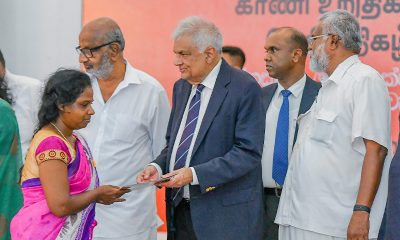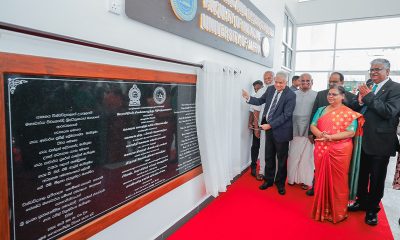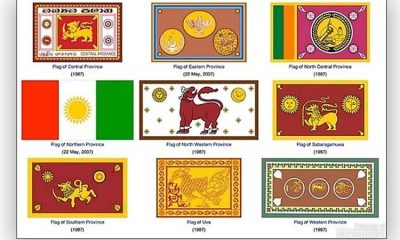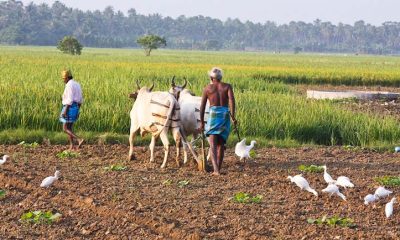Features
The Copper Tumbler and Donkeys in Mannar: A Work of Mourning – IV
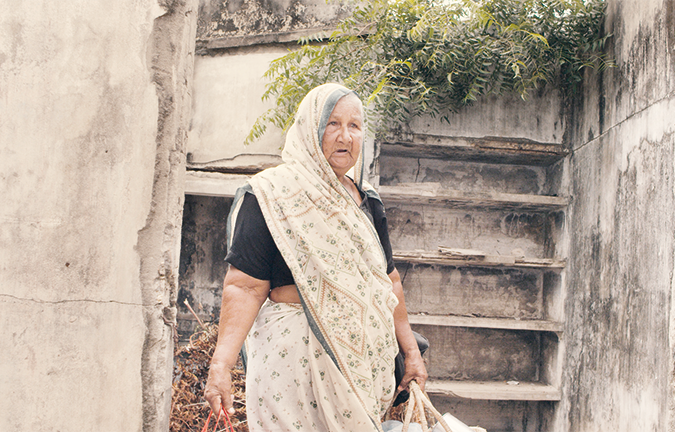
‘it is not narrative that we should abandon but chronology’’
Kumar Shahani
By Laleen Jayamanne
Mourning the Dead: Phaneroscopy
“There is a reality which we each create in our own minds.”
(C.S. Peirce)
The American logician and semiotician C.S. Peirce using the Greek word phaneron, meaning ‘that which appears,’ and adding the suffix skopein, (the Greek word to see, as in Bioscope!), coined the term phaneroscopy. He wanted thereby to capture something common to how we all perceive. He didn’t want to call this subjective mode of seeing an ‘illusion’ or ‘fantasy’ posited against ‘reality’. He elaborated his idea of ‘phaneroscopy’ by saying it is a way of seeing which is not cognitive (being prior to it), a pre-logical, direct awareness, without ego. I think this is much like the way a child, presumably, sees the world before it’s captured in language. Sumathy gives Lalitha phanero-scopic powers. So, as she slowly begins to remember her own childhood in that house, absorbed in the photographs of Jude and of herself as a girl, becoming reflective, but also prodding her siblings insensitively about what actually happened during the war to both the Muslims and to Jude, she begins to perceive visually, what she hears. She herself appears within each of the following events, from which she was in fact absent, away in Canada.
Most of the framed photographs we see in the house are from Sumathy’s own childhood home in Jaffna which she shared with her parents, three sisters and also her two nieces. Even before I learnt this detail, I felt that this home had a shadow cast on it by Sumathy’s own family history which is now public. So, it is the most personal of her films, but she uses her autobiography to testify to those innumerable nameless Muslim folk, too.
The house has shadows, ‘ghosts’ who come in and out. The brother who disappeared, Jude, comes in and out of the film, just as Fatima Teacher does, both as a young woman carrying her precious possessions and then as an old woman. Intriguingly, Sumathy only credits one actor, Asiya Umma, as both the young and the old Fatima Teacher, when realistically one would expect two actors to be named. In the course of the monologue, when her mother tells Lalitha that Fatima Teacher stood right where she now stands, the latter appears. As her head is partly covered by her sari, it is unclear if Fatima Teacher is in fact played by Lalitha, who has inserted herself into that story as she hears it narrated by her crazed mother. But the credits resolve it. However, this sense of uncertainty is important because (disturbed by her mother’s accusatory account of Fatima Teacher), Lalitha creates a film-within- the-film, placing herself in the position of the victim. In appearing at that moment as Fatima Teacher, addressing her friend Daisy Teacher, Lalitha performs an act of mourning.
It’s the musical composition of sequences, with intervals, repetitions and disjunctions between them, which allows Sumathy to abandon chronological progression (without using the usual tired devices like flash-backs as memory images), to play with time in this way.
Three different accounts of Jude’s disappearance are given, two shown. There is that dreaded knock on the heavy wooden door late at night, with two men on a motorbike and car, the boys as they are called, to take Jude away. Lalitha in bed with her cell phone hears the knock and goes to the door in her nighty wrapped in a sheet, asking him to not open the door and watches him being taken away by ‘the boys.’ Earlier there is a snatch of conversation that the story is that the army took Jude away. We see him walking to the church to meet two young Catholic priests, to ask them to intercede with the LTTE, on behalf of the Muslims. Within this sequence we are taken into a large Italianate, grand Catholic church with polished pews and woodwork. But we also see Jude walking into the sea, watched by Lalitha, in the film within the film she creates with herself as a presence.
In this strange retelling, Sumathy is able to make the dead Jude testify to the stories of the many disappeared, without ceasing to be that irreplaceable son of Daisy Teacher. That quiet act of Jude’s suicide, witnessed by Lalitha, standing amongst the braying, foraging donkeys, is a ritual of burial and mourning, an epic cosmos-centric event. The old Fatima Teacher also walks through the mangrove, and earlier through the debris of bomb blasted houses (without their solid timber doors and windows), that might well have been her own dense urban neighbourhood.
In this strange elegiac scene by the sea at night, with the wind and sound of waves lapping the shore, Jude slips off his sarong and simply walks into the ocean slowly. The entire qualitative, tonal, atmospheric mood of the scene amidst nature with Fatima Teacher and Jude and the donkeys as they appear to Lalitha, has a ritualistic, musical quality with its varied rhythms. One exiting life and the other returning from the dead, unreconciled, one might say, amidst the sound of waves. After this long sequence, the film cuts to Jude’s naked corpse washed up on the beach at dawn, spotted by two fishermen who look closely and abandon it.
Lalitha asks her mother to sign over the family home to her. The younger brother asks Lalitha to send the monthly payment for their mother’s expenses directly into his bank account. Neither request is granted. The sister who actually takes care of the mother makes no demands of her more affluent sister but complains about the tedium of her life of chores. But the family gather together with affection as well as acrimony and learn of their trauma and the family history. And the terror of the war years is expressed through a truism of that era by Jesse, who has no time or inclination to linger in the past. She quotes a folk saying of the war years when Lalitha bugs her as to why she didn’t call her or write to her: “People here say those were times when one opened one’s mouth only to drink tea”. A biting sentence condenses the lack of food with terror.
Pedagogy of Film Programming: Suggestions
If a mini retrospective of Sumathy’s body of work is organised, then pairing The Single Tumbler with Ponmani (1976), by Dharmasena Pathiraja, could generate a few more ideas about how to creatively engage with linguistically and culturally diverse communities and cultures, without orientalising Northern landscapes and most especially the ‘Tamil Woman.’ Without a public release in the South and an indifferent short run in Jaffna, now Ponmani has the aura of a classic, one of a kind without a progeny.
This is not quite the case. The way the traditional Hindu Vellala home and its veranda is filmed in Ponmani, finds a different articulation in the way the Christian family inhabits the space of the open house, in the fluid spatial configurations of The Single Tumbler. In both films, changing or frozen family relationships are mapped out spatially through evocative gestures, postures and movements. The traditional Hindu home is marked by silences, while the bilingual Christian home with its different culture is voluble, rather urbane. Sumathy has clearly benefited from Pathi’s work in Jaffna though she is no clone.
It is essential not to forget that this singular film Ponmani was made possible by a visionary tri-lingual higher educational policy formulated by Tamil scholars at the Jaffna University. Pathi and several lecturers were sent to Jaffna University to teach there in the Sinhala medium. During this time, his friendship with Tamil intellectuals and artists resulted in the collaborative film, Ponmani. Until about this time Tamil students from Jaffna were able to study at the National Art School in Colombo along with Sinhala students and there were student exchanges of performances with Jaffna. That was of course possible because lectures were delivered in both English and Sinhala, but with the ‘Sinhala Only’ nationalism hegemonic, English was abandoned.
Sumathy’s documentary Amidst the Villus; Pallaikuli (2021), on the effort of the expelled Muslim populations to return to their homelands would also be important as a companion film to The Single Tumbler.
Ashfaque Mohamed’s debut film Face Cover (2022), with its fine spatial sensitivity and sense of tact, might also be screened together with these two films, to create a generative public context and discourse for these films from different generations and by directors from different ethnicities and set in different regions. He was the assistant director on The Single Tumbler. Sumathy has been a mentor to him and also played the Muslim mother in Face Cover.
Also, perhaps a few of Rukmani Devi’s and Mohideen Baig’s films might be part of it, and Sarungale by Sunil Ariyaratne, where Gamini Fonseka plays the role of a Tamil clerk, might also work well in such a non-linear, thematic mix. Sumathy’s Sons and Fathers about the multi-ethnic composition of the Lankan film industry during July ’83, would create a new political perspective on these films. Ingirunthu remembers the disenfranchisement of the tea estate workers at independence and also the deportation of a large number to India in 1964, despite having lived and worked in Ceylon for generations.
Expulsion of the Muslims
The Expulsion of the Muslims (estimated at 75,000), from the Northern Province by the LTTE is an event of epic magnitude in Lankan history. Refusing to forget the event and its aftermath, The Single Tumbler was made in collaboration with a dedicated ensemble cast and crew (with Sunil Perera’s cinematography, Elmo Halliday on editing and sound design, music direction by Kausikan Rajeshkumar), with a modest budget, but with a sophisticated understanding of ‘film as a form that thinks.’
That dented and burned single copper tumbler on fire is hard to forget, just like Sumathy’s other such images powered by fire. The fiery copper tumbler brings to mind two sentences by the French philosopher Deleuze, in a short piece written just before he committed suicide, being terminally ill. The brusque note, written in haste, is called ‘The Actual and the Virtual’.
He says: ‘Purely actual objects do not exist. Every actual surrounds itself with a cloud of virtual images.’ This idea of ‘virtual images’ Deleuze owes to Henri Bergson who wrote a book titled Matter and Memory in 1895, the year the very first films were projected in Paris. And for Bergson, the concept of the ‘virtual’ is opposed to time as chronology, time as the simple linear succession of past, present and future. He says, speaking more like a poet, that the ‘virtual’, or duration, appears to us in its fullness when we are drunk with wine or dream, or in love, when all that has happened coexists in an intense, expansive present, open to a potentialized future. Film is surely the gift that plunges us into this cloud of virtuality – sometimes; as with The Single Tumbler. (Concluded)
Features
The heart-friendly health minister

by Dr Gotabhya Ranasinghe
Senior Consultant Cardiologist
National Hospital Sri Lanka
When we sought a meeting with Hon Dr. Ramesh Pathirana, Minister of Health, he graciously cleared his busy schedule to accommodate us. Renowned for his attentive listening and deep understanding, Minister Pathirana is dedicated to advancing the health sector. His openness and transparency exemplify the qualities of an exemplary politician and minister.
Dr. Palitha Mahipala, the current Health Secretary, demonstrates both commendable enthusiasm and unwavering support. This combination of attributes makes him a highly compatible colleague for the esteemed Minister of Health.
Our discussion centered on a project that has been in the works for the past 30 years, one that no other minister had managed to advance.
Minister Pathirana, however, recognized the project’s significance and its potential to revolutionize care for heart patients.
The project involves the construction of a state-of-the-art facility at the premises of the National Hospital Colombo. The project’s location within the premises of the National Hospital underscores its importance and relevance to the healthcare infrastructure of the nation.
This facility will include a cardiology building and a tertiary care center, equipped with the latest technology to handle and treat all types of heart-related conditions and surgeries.
Securing funding was a major milestone for this initiative. Minister Pathirana successfully obtained approval for a $40 billion loan from the Asian Development Bank. With the funding in place, the foundation stone is scheduled to be laid in September this year, and construction will begin in January 2025.
This project guarantees a consistent and uninterrupted supply of stents and related medications for heart patients. As a result, patients will have timely access to essential medical supplies during their treatment and recovery. By securing these critical resources, the project aims to enhance patient outcomes, minimize treatment delays, and maintain the highest standards of cardiac care.
Upon its fruition, this monumental building will serve as a beacon of hope and healing, symbolizing the unwavering dedication to improving patient outcomes and fostering a healthier society.We anticipate a future marked by significant progress and positive outcomes in Sri Lanka’s cardiovascular treatment landscape within the foreseeable timeframe.
Features
A LOVING TRIBUTE TO JESUIT FR. ALOYSIUS PIERIS ON HIS 90th BIRTHDAY

by Fr. Emmanuel Fernando, OMI
Jesuit Fr. Aloysius Pieris (affectionately called Fr. Aloy) celebrated his 90th birthday on April 9, 2024 and I, as the editor of our Oblate Journal, THE MISSIONARY OBLATE had gone to press by that time. Immediately I decided to publish an article, appreciating the untiring selfless services he continues to offer for inter-Faith dialogue, the renewal of the Catholic Church, his concern for the poor and the suffering Sri Lankan masses and to me, the present writer.
It was in 1988, when I was appointed Director of the Oblate Scholastics at Ampitiya by the then Oblate Provincial Fr. Anselm Silva, that I came to know Fr. Aloy more closely. Knowing well his expertise in matters spiritual, theological, Indological and pastoral, and with the collaborative spirit of my companion-formators, our Oblate Scholastics were sent to Tulana, the Research and Encounter Centre, Kelaniya, of which he is the Founder-Director, for ‘exposure-programmes’ on matters spiritual, biblical, theological and pastoral. Some of these dimensions according to my view and that of my companion-formators, were not available at the National Seminary, Ampitiya.
Ever since that time, our Oblate formators/ accompaniers at the Oblate Scholasticate, Ampitiya , have continued to send our Oblate Scholastics to Tulana Centre for deepening their insights and convictions regarding matters needed to serve the people in today’s context. Fr. Aloy also had tried very enthusiastically with the Oblate team headed by Frs. Oswald Firth and Clement Waidyasekara to begin a Theologate, directed by the Religious Congregations in Sri Lanka, for the contextual formation/ accompaniment of their members. It should very well be a desired goal of the Leaders / Provincials of the Religious Congregations.
Besides being a formator/accompanier at the Oblate Scholasticate, I was entrusted also with the task of editing and publishing our Oblate journal, ‘The Missionary Oblate’. To maintain the quality of the journal I continue to depend on Fr. Aloy for his thought-provoking and stimulating articles on Biblical Spirituality, Biblical Theology and Ecclesiology. I am very grateful to him for his generous assistance. Of late, his writings on renewal of the Church, initiated by Pope St. John XX111 and continued by Pope Francis through the Synodal path, published in our Oblate journal, enable our readers to focus their attention also on the needed renewal in the Catholic Church in Sri Lanka. Fr. Aloy appreciated very much the Synodal path adopted by the Jesuit Pope Francis for the renewal of the Church, rooted very much on prayerful discernment. In my Religious and presbyteral life, Fr.Aloy continues to be my spiritual animator / guide and ongoing formator / acccompanier.
Fr. Aloysius Pieris, BA Hons (Lond), LPh (SHC, India), STL (PFT, Naples), PhD (SLU/VC), ThD (Tilburg), D.Ltt (KU), has been one of the eminent Asian theologians well recognized internationally and one who has lectured and held visiting chairs in many universities both in the West and in the East. Many members of Religious Congregations from Asian countries have benefited from his lectures and guidance in the East Asian Pastoral Institute (EAPI) in Manila, Philippines. He had been a Theologian consulted by the Federation of Asian Bishops’ Conferences for many years. During his professorship at the Gregorian University in Rome, he was called to be a member of a special group of advisers on other religions consulted by Pope Paul VI.
Fr. Aloy is the author of more than 30 books and well over 500 Research Papers. Some of his books and articles have been translated and published in several countries. Among those books, one can find the following: 1) The Genesis of an Asian Theology of Liberation (An Autobiographical Excursus on the Art of Theologising in Asia, 2) An Asian Theology of Liberation, 3) Providential Timeliness of Vatican 11 (a long-overdue halt to a scandalous millennium, 4) Give Vatican 11 a chance, 5) Leadership in the Church, 6) Relishing our faith in working for justice (Themes for study and discussion), 7) A Message meant mainly, not exclusively for Jesuits (Background information necessary for helping Francis renew the Church), 8) Lent in Lanka (Reflections and Resolutions, 9) Love meets wisdom (A Christian Experience of Buddhism, 10) Fire and Water 11) God’s Reign for God’s poor, 12) Our Unhiddden Agenda (How we Jesuits work, pray and form our men). He is also the Editor of two journals, Vagdevi, Journal of Religious Reflection and Dialogue, New Series.
Fr. Aloy has a BA in Pali and Sanskrit from the University of London and a Ph.D in Buddhist Philosophy from the University of Sri Lankan, Vidyodaya Campus. On Nov. 23, 2019, he was awarded the prestigious honorary Doctorate of Literature (D.Litt) by the Chancellor of the University of Kelaniya, the Most Venerable Welamitiyawe Dharmakirthi Sri Kusala Dhamma Thera.
Fr. Aloy continues to be a promoter of Gospel values and virtues. Justice as a constitutive dimension of love and social concern for the downtrodden masses are very much noted in his life and work. He had very much appreciated the commitment of the late Fr. Joseph (Joe) Fernando, the National Director of the Social and Economic Centre (SEDEC) for the poor.
In Sri Lanka, a few religious Congregations – the Good Shepherd Sisters, the Christian Brothers, the Marist Brothers and the Oblates – have invited him to animate their members especially during their Provincial Congresses, Chapters and International Conferences. The mainline Christian Churches also have sought his advice and followed his seminars. I, for one, regret very much, that the Sri Lankan authorities of the Catholic Church –today’s Hierarchy—- have not sought Fr.
Aloy’s expertise for the renewal of the Catholic Church in Sri Lanka and thus have not benefited from the immense store of wisdom and insight that he can offer to our local Church while the Sri Lankan bishops who governed the Catholic church in the immediate aftermath of the Second Vatican Council (Edmund Fernando OMI, Anthony de Saram, Leo Nanayakkara OSB, Frank Marcus Fernando, Paul Perera,) visited him and consulted him on many matters. Among the Tamil Bishops, Bishop Rayappu Joseph was keeping close contact with him and Bishop J. Deogupillai hosted him and his team visiting him after the horrible Black July massacre of Tamils.
Features
A fairy tale, success or debacle

Sri Lanka-Singapore Free Trade Agreement
By Gomi Senadhira
senadhiragomi@gmail.com
“You might tell fairy tales, but the progress of a country cannot be achieved through such narratives. A country cannot be developed by making false promises. The country moved backward because of the electoral promises made by political parties throughout time. We have witnessed that the ultimate result of this is the country becoming bankrupt. Unfortunately, many segments of the population have not come to realize this yet.” – President Ranil Wickremesinghe, 2024 Budget speech
Any Sri Lankan would agree with the above words of President Wickremesinghe on the false promises our politicians and officials make and the fairy tales they narrate which bankrupted this country. So, to understand this, let’s look at one such fairy tale with lots of false promises; Ranil Wickremesinghe’s greatest achievement in the area of international trade and investment promotion during the Yahapalana period, Sri Lanka-Singapore Free Trade Agreement (SLSFTA).
It is appropriate and timely to do it now as Finance Minister Wickremesinghe has just presented to parliament a bill on the National Policy on Economic Transformation which includes the establishment of an Office for International Trade and the Sri Lanka Institute of Economics and International Trade.
Was SLSFTA a “Cleverly negotiated Free Trade Agreement” as stated by the (former) Minister of Development Strategies and International Trade Malik Samarawickrama during the Parliamentary Debate on the SLSFTA in July 2018, or a colossal blunder covered up with lies, false promises, and fairy tales? After SLSFTA was signed there were a number of fairy tales published on this agreement by the Ministry of Development Strategies and International, Institute of Policy Studies, and others.
However, for this article, I would like to limit my comments to the speech by Minister Samarawickrama during the Parliamentary Debate, and the two most important areas in the agreement which were covered up with lies, fairy tales, and false promises, namely: revenue loss for Sri Lanka and Investment from Singapore. On the other important area, “Waste products dumping” I do not want to comment here as I have written extensively on the issue.
1. The revenue loss
During the Parliamentary Debate in July 2018, Minister Samarawickrama stated “…. let me reiterate that this FTA with Singapore has been very cleverly negotiated by us…. The liberalisation programme under this FTA has been carefully designed to have the least impact on domestic industry and revenue collection. We have included all revenue sensitive items in the negative list of items which will not be subject to removal of tariff. Therefore, 97.8% revenue from Customs duty is protected. Our tariff liberalisation will take place over a period of 12-15 years! In fact, the revenue earned through tariffs on goods imported from Singapore last year was Rs. 35 billion.
The revenue loss for over the next 15 years due to the FTA is only Rs. 733 million– which when annualised, on average, is just Rs. 51 million. That is just 0.14% per year! So anyone who claims the Singapore FTA causes revenue loss to the Government cannot do basic arithmetic! Mr. Speaker, in conclusion, I call on my fellow members of this House – don’t mislead the public with baseless criticism that is not grounded in facts. Don’t look at petty politics and use these issues for your own political survival.”
I was surprised to read the minister’s speech because an article published in January 2018 in “The Straits Times“, based on information released by the Singaporean Negotiators stated, “…. With the FTA, tariff savings for Singapore exports are estimated to hit $10 million annually“.
As the annual tariff savings (that is the revenue loss for Sri Lanka) calculated by the Singaporean Negotiators, Singaporean $ 10 million (Sri Lankan rupees 1,200 million in 2018) was way above the rupees’ 733 million revenue loss for 15 years estimated by the Sri Lankan negotiators, it was clear to any observer that one of the parties to the agreement had not done the basic arithmetic!
Six years later, according to a report published by “The Morning” newspaper, speaking at the Committee on Public Finance (COPF) on 7th May 2024, Mr Samarawickrama’s chief trade negotiator K.J. Weerasinghehad had admitted “…. that forecasted revenue loss for the Government of Sri Lanka through the Singapore FTA is Rs. 450 million in 2023 and Rs. 1.3 billion in 2024.”
If these numbers are correct, as tariff liberalisation under the SLSFTA has just started, we will pass Rs 2 billion very soon. Then, the question is how Sri Lanka’s trade negotiators made such a colossal blunder. Didn’t they do their basic arithmetic? If they didn’t know how to do basic arithmetic they should have at least done their basic readings. For example, the headline of the article published in The Straits Times in January 2018 was “Singapore, Sri Lanka sign FTA, annual savings of $10m expected”.
Anyway, as Sri Lanka’s chief negotiator reiterated at the COPF meeting that “…. since 99% of the tariffs in Singapore have zero rates of duty, Sri Lanka has agreed on 80% tariff liberalisation over a period of 15 years while expecting Singapore investments to address the imbalance in trade,” let’s turn towards investment.
Investment from Singapore
In July 2018, speaking during the Parliamentary Debate on the FTA this is what Minister Malik Samarawickrama stated on investment from Singapore, “Already, thanks to this FTA, in just the past two-and-a-half months since the agreement came into effect we have received a proposal from Singapore for investment amounting to $ 14.8 billion in an oil refinery for export of petroleum products. In addition, we have proposals for a steel manufacturing plant for exports ($ 1 billion investment), flour milling plant ($ 50 million), sugar refinery ($ 200 million). This adds up to more than $ 16.05 billion in the pipeline on these projects alone.
And all of these projects will create thousands of more jobs for our people. In principle approval has already been granted by the BOI and the investors are awaiting the release of land the environmental approvals to commence the project.
I request the Opposition and those with vested interests to change their narrow-minded thinking and join us to develop our country. We must always look at what is best for the whole community, not just the few who may oppose. We owe it to our people to courageously take decisions that will change their lives for the better.”
According to the media report I quoted earlier, speaking at the Committee on Public Finance (COPF) Chief Negotiator Weerasinghe has admitted that Sri Lanka was not happy with overall Singapore investments that have come in the past few years in return for the trade liberalisation under the Singapore-Sri Lanka Free Trade Agreement. He has added that between 2021 and 2023 the total investment from Singapore had been around $162 million!
What happened to those projects worth $16 billion negotiated, thanks to the SLSFTA, in just the two-and-a-half months after the agreement came into effect and approved by the BOI? I do not know about the steel manufacturing plant for exports ($ 1 billion investment), flour milling plant ($ 50 million) and sugar refinery ($ 200 million).
However, story of the multibillion-dollar investment in the Petroleum Refinery unfolded in a manner that would qualify it as the best fairy tale with false promises presented by our politicians and the officials, prior to 2019 elections.
Though many Sri Lankans got to know, through the media which repeatedly highlighted a plethora of issues surrounding the project and the questionable credentials of the Singaporean investor, the construction work on the Mirrijiwela Oil Refinery along with the cement factory began on the24th of March 2019 with a bang and Minister Ranil Wickremesinghe and his ministers along with the foreign and local dignitaries laid the foundation stones.
That was few months before the 2019 Presidential elections. Inaugurating the construction work Prime Minister Ranil Wickremesinghe said the projects will create thousands of job opportunities in the area and surrounding districts.
The oil refinery, which was to be built over 200 acres of land, with the capacity to refine 200,000 barrels of crude oil per day, was to generate US$7 billion of exports and create 1,500 direct and 3,000 indirect jobs. The construction of the refinery was to be completed in 44 months. Four years later, in August 2023 the Cabinet of Ministers approved the proposal presented by President Ranil Wickremesinghe to cancel the agreement with the investors of the refinery as the project has not been implemented! Can they explain to the country how much money was wasted to produce that fairy tale?
It is obvious that the President, ministers, and officials had made huge blunders and had deliberately misled the public and the parliament on the revenue loss and potential investment from SLSFTA with fairy tales and false promises.
As the president himself said, a country cannot be developed by making false promises or with fairy tales and these false promises and fairy tales had bankrupted the country. “Unfortunately, many segments of the population have not come to realize this yet”.
(The writer, a specialist and an activist on trade and development issues . )




